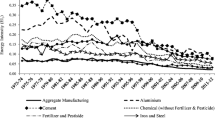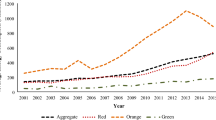Abstract
This chapter is an attempt to understand the relationship between the labour and energy intensity for firms drawn from pulp and paper industries in Indian manufacturing. Pulp and paper industry accounts for a considerable share of the industrial enterprises, production, employment and exports in the Indian economy and also one of the energy-intensive industries in Indian manufacturing. This chapter uses data from the Centre for Monitoring Indian Economy (CMIE), at the unit level for the period 1992–2000. Analysis from the cross-tabulation of energy and labour intensity of the firms in this industry suggests that energy intensity is higher for the BSE-listed firms; however, the labour intensity is found higher for the non-listed firms. Further, energy and labour intensity is higher for the domestic when compared to foreign firms. The econometric analysis of the energy intensity and other firm-specific characteristics suggests that labour and energy intensity has an inverted U-shape relationship, suggesting a substitution possibility between energy and labour for the pulp and paper industries in India. The listed firms are found to be more energy intensive as compared to the non-listed firms. More importantly, technology import is found negatively related to energy intensity of firms, suggesting that firms in these industries could be using technology import and knowledge sharing from their foreign collaborators for energy saving.
Access this chapter
Tax calculation will be finalised at checkout
Purchases are for personal use only
Similar content being viewed by others
Notes
- 1.
Industrialized countries that are listed in Annex-I of the UN Framework Convention on Climate Change; for details, see http://www.oecd.org/document/13/0,3343,en_2649_34361_1849485_1_1_1_1,00.html
References
Ahluwalia IJ (1991) Productivity and growth in Indian manufacturing – trends in productivity and growth. Oxford University Press, New York/New Delhi
Allen RGD (1938) Mathematical analysis for economists. St. Martin’s Press, New York
Balasubrahmanya MH (2006) Labour productivity, energy intensity and economic performance in small enterprises: a study of brick enterprises cluster in India. Energy Conver Manage 47:763–777
Barnett AH, Reutter K, Thompson H (1998) Electricity substitution: some local industrial evidence. Energy Econ 20:411–419
Caloghiro Y, Mourelatos A, Thompson H (1997) Industrial energy substitution during the 1980s in the Greek economy. Energy Econ 19:476–491
Cameron T, Schwartz SL (1980) Inflationary expectations and the demand for capital, labor, and energy in Canadian manufacturing industries. In: Ziemba WT et al (eds) Energy policy modeling: U.S. and Canadian experiences. Matinus Nijhoff Publishing, Boston
Chang K (1994) Capital-energy substitution and the multi-level CES production function. Energy Econ 16:22–26
Chaudhuri S (2002) Economic reforms and industrial structure in India. Econ Pol Wkly 37(02):155–162
Christensen LR, Jorgenson D, Lau LJ (1971) Conjugate duality and the transcendental logarithmic production function. Econometrica 39:255–256
Cohen M (1998) Monitoring and enforcement of environmental policy. In: Tietenberg T, Folmer H (eds) International yearbook of environmental and resource economics, vol III. Edward Elgar Publishers, Northampton
Das D, Wadhwa D, Kalita G (2009) The employment potential of labor intensive industries in India’s organized manufacturing. Working paper no. 236. Indian Council for Research on International Economic Relations, New Delhi
Denison EF (1974) Accounting for United States economic growth 1929 to 1969. Brookings Institution, Washington, DC
Denison EF (1979) Accounting for slower economic growth. Brookings Institution, Washington, DC
Denison EF (1985) Trends in American economic growth 1929–1982. Brookings Institution, Washington, DC
Denny M, Fuss M, Waverman L (1981) Substitution possibilities for energy: evidence from US and Canadian manufacturing industries. In: Berndt ER, Field BC (eds) Modeling and measuring natural resource substitution. MIT Press, Cambridge
Doonan J, Lanoie P, Laplante B (2005) Determinants of environment performance in Canadian pulp and paper industries: an assessment from inside the industry. Ecol Econ 55:73–84
Easterly W, Levine R (2002) Chapter 3: It’s not factor accumulation: stylized facts and growth models. In: Klaus S-H (ed) Economic growth: sources, trends, and cycles, vol 6, 1st edn. Central Bank of Chile, Santiago, pp 061–114
Felipe J (1997) Total factor productivity growth in East Asia: a critical survey, EDRC report series number 65, Economics and Development Resource Center, Asian Development Bank
Foulon J, Lanoie P, Laplante B (2002) Incentives for pollution control: regulation or information? J Environ Econ Manage 44:169–187
Ganguli I, Roy J (1995) Oil demand elasticities in India. Indian J Appl Econ 5(1):75–87
Goldar B (2000) Employment growth in organized manufacturing in India. Econ Pol Wkly 35(14):1191–1195
Goldar B (2010) Energy intensity of Indian manufacturing firms: effect of energy prices, technology and other firm characteristics. Paper presented during the conference on frontier issues in technology, Development and Environment at MSE, Chennai
Hogan W, Jorgenson D (1991) Productivity trends and the cost of reducing CO2 emissions. Energy J 12(1):67–85
Hseu JS, Shang JK (2005) Productivity changes of pulp and paper industry in OECD countries 1991–2000: a non-parametric malmquist approach. For Policy Econ 7:411–422
Hudson EA, Jorgenson D (1974) US energy policy and economic growth 1975–2000. Bell J Econ Manage Sci 5:461–514
Jha R, Murty MN, Paul S, Rao BB (1993) An analysis of technological change, factor substitution and economies of scale in manufacturing industries in India. Appl Econ 25:1337–1343
Jorgenson DW, Fraumeni BM (1981) Relative prices and technical change. In: Berndt ER, Fields B (eds) Modeling and measuring natural resources substitution. MIT Press, Cambridge
Jorgenson DW, Gollop FM, Fraumeni M (1987) Productivity and U.S. economic growth. North Holland, Amsterdam/Oxford
Kumar A (2003) Energy intensity: a quantitative exploration for Indian manufacturing. IGIDR Working paper no. 152. http://dx.doi.org/10.2139/ssrn.468440
Lashof D, Tirpak D (eds) (1990) Policy options for stabilizing global climate: report to Congress, Executive summary, US Environmental Protection Agency, No. 21
Li X, Buongiorno J, Ince PJ (2004) Effects of size and age on the survival and growth of pulp and paper mills. J For Econ 10:3–9
Ma H, Oxley L, Gibson J (2009) Substitution possibilities and determinants of energy intensity for China. Energy Policy 37:1793–1804
Mahmud S (2000) The energy demand in the manufacturing sector of Pakistan: some further results. Energy Econ 22:641–648
Mongia P, Sathaye J (1998a) Productivity trends in India’s energy intensive industries: a growth accounting analysis, Lawrence Berkeley National Laboratory. Working paper no. 41838, Berkeley, CA
Mongia P, Sathaye J (1998b) Productivity growth and technical change in India’s energy intensive industries – a survey, Lawrence Berkeley National Laboratory. Working paper no. 41840, Berkeley, CA
Mongia P, Schumacher K, Sathaye J (2001) Policy reforms and productivity growth in India’s energy intensive industries. Energy Policy 29:715–724
Nagaraj R (2004) Fall in organized manufacturing employment – a brief note. Econ Pol Wkly 39(30):3387–3390
Pradhan G, Barik K (1999) Total factor productivity growth in developing economies: a study of selected industries in India. Econ Pol Wkly 34(31):M92–M97
Roy J (1992) Demand for energy in Indian manufacturing industries. Daya Publishing, New Delhi
Roy J, Sathaye J, Sanstad A, Mongia P, Schumacher K (1999) Productivity trends in India’s energy intensive industries. Energy J 20(3):33–61
Sahu SK, Narayanan K (2010) Determinants of energy intensity in Indian manufacturing industries: a firm level analysis. MPRA paper no. 21646, University Library of Munich, Munich
Sahu SK, Narayanan K (2011) Determinants of energy intensity in Indian manufacturing industries: a firm level study. Eurasian J Econ Bus 4(8):13–30
Sarkar S, Roy J (1995) Inter-fuel substitution during post oil embargo period - case study of two energy intensive manufacturing industries in India. The Indian Econ J 43(2):33–46
Sathaye JA, Ravindranath NH (1998) Climate change mitigation in the energy and forestry sectors of developing countries. Annu Rev Eng Environ 23:387–437
Schumacher K, Sathaye J (1999) India’s pulp and paper industry: productivity and energy efficiency. Ernest Orlando Lawrence Berkeley National Laboratory, LBNL-41843
Solow RM (1957) Technical change and the aggregate production function. Rev Econ Stat 39:312–320
Takayama A (1993) Analytical methods in economics. University of Michigan Press, Ann Harbor
Uma R, Unni J (2004) Unorganized and organized manufacturing in India: potential for employment generating growth. Econ Pol Wkly 39(41):4568–4580
UNFCCC (1998) Kyoto protocol to the United Nations Framework Convention on climate change, available at http://unfccc.int/resource/docs/convkp/kpeng.pdf
Varian HR (1984) Microeconomic analysis. W. W. Norton & Company, New York
Weyant J, Davidson O, Dowlatabadi H, Edmonds J, Grubb M, Parson EA, Richels R, Rotmans J, Shukla PR, Tol RSJ, Cline W, Fankhauser S (1996) Integrated assessment of climate change: an overview and comparison of approaches and results. In: Bruce JP, Lee H, Erik HF (eds) Climate change 1995 – economic and social dimensions of climate change. Cambridge University Press, New York
World Bank (2000) Greening industry: new roles for communities, markets, and governments. World Bank/Oxford University Press, Washington, DC
Yi F (2000) Dynamic energy-demand models: a comparison. Energy Econ 22:285–297
Acknowledgement
We gratefully acknowledge comments and suggestions by Prof. B. N. Goldar and Prof. N. S. Siddharthan. The errors that remain are our own.
Author information
Authors and Affiliations
Corresponding author
Editor information
Editors and Affiliations
Rights and permissions
Copyright information
© 2013 Springer India
About this chapter
Cite this chapter
Sahu, S.K., Narayanan, K. (2013). Labour and Energy Intensity: A Study of the Pulp and Paper Industries in India. In: Siddharthan, N., Narayanan, K. (eds) Human Capital and Development. Springer, India. https://doi.org/10.1007/978-81-322-0857-0_5
Download citation
DOI: https://doi.org/10.1007/978-81-322-0857-0_5
Published:
Publisher Name: Springer, India
Print ISBN: 978-81-322-0856-3
Online ISBN: 978-81-322-0857-0
eBook Packages: Business and EconomicsBusiness and Management (R0)




